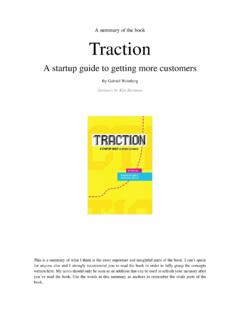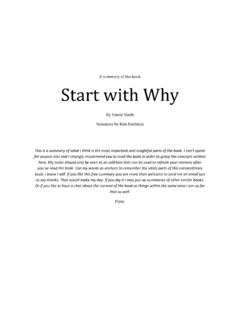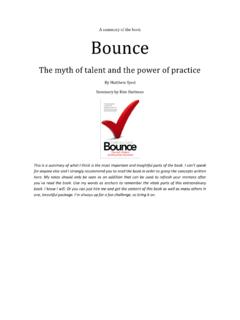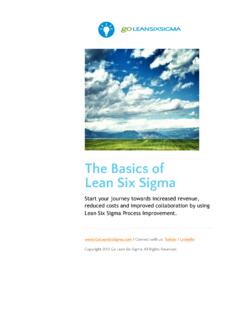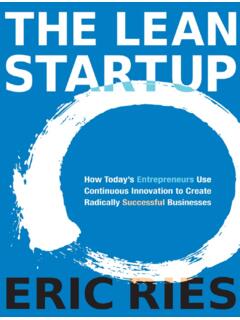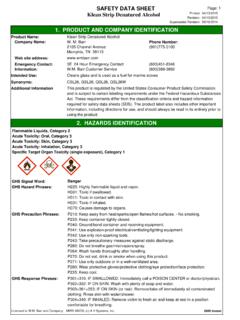Transcription of The Lean Startup summary - Kim Hartman
1 A summary of the book The lean Startup How Today's Entrepreneurs Use Continuous Innovation to Create Radically Successful Businesses By Eric Ries summary by Kim Hartman This is a summary of what I think is the most important and insightful parts of the book. I can t speak for anyone else and I strongly recommend you to read the book in order to fully grasp the concepts written here. My notes should only be seen as an addition that can be used to refresh your memory after you ve read the book. Use the words in this summary as anchors to remember the vitals parts of the book. More book summaries at Contact me at 1 Contents Description from amazon .. 2 Part One - 3 Chapter 1 Start .. 3 Chapter 2: Define .. 4 Chapter 3: Learn .. 5 Validated Learning .. 5 Chapter 4: Experiment .. 6 Part two: Steer .. 7 The feedback loop .. 7 Chapter 5: Leap .. 8 Chapter 6: Test.
2 9 Early adopters .. 9 Chapter 7: Measure .. 11 Innovation accounting .. 11 Metrics .. 12 Chapter 8: Pivot or Preserve .. 14 Part three Accelerate .. 16 Chapter 9: Batch .. 18 Chapter 10: Grow .. 21 Chapter 11: Adapt .. 23 The five why s .. 23 Chapter 12: Innovate .. 25 The innovation sandbox .. 25 More book summaries .. 27 More book summaries at Contact me at 2 Description from amazon Eric Ries defines a Startup as an organization dedicated to creating something new under conditions of extreme uncertainty. This is just as true for one person in a garage or a group of seasoned professionals in a Fortune 500 boardroom. What they have in common is a mission to penetrate that fog of uncertainty to discover a successful path to a sustainable business. The lean Startup approach fosters companies that are both more capital efficient and that leverage human creativity more effectively.
3 Inspired by lessons from lean manufacturing, it relies on validated learning, rapid scientific experimentation, as well as a number of counter-intuitive practices that shorten product development cycles, measure actual progress without resorting to vanity metrics, and learn what customers really want. It enables a company to shift directions with agility, altering plans inch by inch, minute by minute. Rather than wasting time creating elaborate business plans, The lean Startup offers entrepreneurs - in companies of all sizes - a way to test their vision continuously, to adapt and adjust before it s too late. Ries provides a scientific approach to creating and managing successful startups in a age when companies need to innovate more than ever. More book summaries at Contact me at 3 Part One - Vision Chapter 1 Start The myth of the loss of manufacturing capabilities: The huge productivity increases made possible by modern mismanagement and technology have created more productivity capacity than firms know what to do with.
4 More output, less jobs. lean thinking: drawing on the knowledge and creativity of individual workers, shrinking batch sizes, just-in-time production and inventory control, acceleration of cycle times. Progress measure: Instead of measuring progress in manufacturing by the production of high-quality physical goods, the lean Startup measure progress through validated learning. Productivity: When people are used to evaluating their productivity locally, they feel that a good day is one in which they did their job well all day. The lean Startup asks people to figure out the right thing to build the thing customers want and will pay for as quickly as possible. Build-measure-learn feedback loop: instead of making a lot of assumptions, you can make constant adjustments with a steering wheel called build-measure-learn. Through this process we can learn if and when to make a sharp turn a pivot.
5 More book summaries at Contact me at 4 Chapter 2: Define Innovation factory: A company s only sustainable path to long-term economic growth is to build an innovation factory that uses lean Startup techniques to create disruptive innovations on a continuous basis. Culture and systems: It s moving leaders from playing Caesar with their thumbs up and down on every idea to instead putting in a culture and the systems so that teams can move and innovate at the speed of the experimentation system. More book summaries at Contact me at 5 Chapter 3: Learn Validated Learning Validated learning is not after-the-fact rationalization or a good story designed to hide failure. It is a rigorous method for demonstrating progress when one is embedded in the soil of extreme uncertainty in which startups grow. Validated learning is the process of demonstrating empirically that a team has discovered valuable truths about a startups present and future business prospects.
6 It is more concrete, more accurate, and faster than market forecasting or classical business planning. Learning is the essential unit of progress for startups. The effort that is not absolutely necessary for learning what customers want can be eliminated. This is validated learning, because it is always demonstrated by positive improvements in the startups core metrics. Validated learning is backed up by empirical data collected from real customers. The way forward is to learn to see every Startup in any industry as a grand experiment. The question is not can this product be built? but can this product be built? and can we build a sustainable business around this set of products and services. Your job is to find a synthesis between your vision and what customers would accept; it wasn t to capitulate to what customers thought they wanted or to tell customers what they ought to want.
7 True Startup productivity: systematically figuring out the right things to build. In the lean Startup , every product , every feature, every marketing campaign everything a Startup does is understood to be an experiment designed to achieve validated learning. lean thinking: lean thinking defines value as providing benefit to the customer, anything else is waste. In a manufacturing business, customers don t care how the product is assembled, only that it works correctly. But in a Startup , who the customer is and what the customer might find valuable are unknown, part of the very uncertainty that is an essential part of the definition of a Startup . More book summaries at Contact me at 6 Chapter 4: Experiment One of the most important lessons of the scientific method if you cannot fail, you cannot learn. The experiment phase: it begins with a clear hypothesis that makes predictions about what is supposed to happen.
8 Startup experimentation is guided by the startups vision. The goal of every Startup experiment is to discover how to build a sustainable business around that vision. Even when experiments produce a negative result, those failures prove instructive and can influence strategy. In the lean Startup model, an experiment is more than just a theoretical inquiry; it is also a first product . The two most important assumptions entrepreneurs make are: The value hypothesis test whether a product or service really delivers value to customers once using it. The growth hypothesis test how new customers will discover a product or service. The product manager usually says I want this , and the engineer answers I am going to build that . Instead answer 4 questions: 1. Do consumers recognize that they have the problem you are trying to solve? 2. If there was a solution, would they buy it?
9 3. Would they buy it from us? 4. Can we build a solution for that problem? Success is not delivering a feature; success is learning how to solve the customer s problem. More book summaries at Contact me at 7 Part two: Steer The feedback loop Ideas > build > product > measure > data > learn > ideas > and so on (circle) Image source (thanks) Minimizing the total time: Many people have training that emphasizes one element of the feedback loop. But having the best business idea or the best designed product isn t enough; we need to focus our energies on minimizing the total time through this feedback loop. Minimum Viable product : Once clear on the leap-of-faith decisions, the first step is to enter the build phase as quickly as possible with a minimum viable product MVP. The MVP is that version of the product that enables a full turn of the build-measure-learn loop with a minimum amount of effort and the least amount of development time.
10 Learning milestones: an alternative to traditional business and product milestones. Learning milestones are useful for entrepreneurs as a way of assessing their progress accurately and objectively. More book summaries at Contact me at 8 Chapter 5: Leap Startup strategy: For startups, the role of strategy is to help figure out the right questions to ask. The first challenge for an entrepreneur is to build an organization that can test these assumptions systematically. The second challenge, as in all entrepreneurial situations, is to perform that rigorous testing without losing sight of the company s overall vision. Leap-of-faith assumptions: The riskiest elements of a Startup plan are the leap-of-faith assumptions. The two most important assumptions are the value hypothesis and the growth hypothesis. These give rise to tuning variables that control a startups engine of growth.

